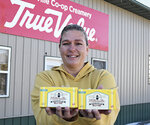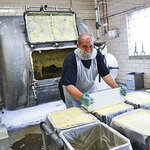MILLERVILLE, Minn. – Not much draws attention to a rural town quite like butter does to Millerville.
For 93 years, the Millerville Cooperative Creamery has made 1-pound blocks of butter for customers near and far to enjoy.
“People come from all over for our butter, some from Alaska and Montana,” Deidre Hubbard said. “It really speaks for itself.”
Hubbard is the creamery’s general manager.
While not an operating creamery in the normal sense of the word, Millerville Cooperative Creamery continues on a tradition the business was founded on in the 1900s. Every two weeks, Hubbard’s husband, Eric, embarks on the three-day process of making butter.
The creamery purchases cream from Land O’Lakes in Melrose, which is then hauled to the Millerville location as the start of the first day of production.
Cream is placed in a batch pasteurizer where it is brought to a high temperature and held for 30 minutes, then allowed to cool overnight.
“That long process gives the cream a sweeter taste,” Hubbard said. “It’s what makes Millerville butter Millerville butter.”
Hubbard explained how most butter is produced with a high-temperature short-time pasteurization and continuous churn system where upwards of 20,000 pounds of butter can be produced in an hour.
In Hubbard’s facility, the process reconvenes on day two, when the pasteurized cream is pumped into a churn. At that moment, the liquid is churned until it has the consistency of popcorn.
On average, that part of the process takes about an hour, depending on the fat content of the cream, Hubbard said.
Then, the buttermilk is drained and salt is added, and the churning continues until the butter becomes creamy.
From there, the butter is taken out of the churn by hand and placed into 90-pound stainless steel frames to set overnight. The next day, the butter is removed from the frames, cut into 1-pound blocks, and wrapped and boxed for retail.
“We’re fortunate that one person can do it all,” Hubbard said. “Once we get to the cutting and wrapping, though, we do have two or three additional people helping.”
Each batch generates about 1,100 pounds of butter to be sold in the creamery’s storefront and 45 additional locations across the state and Fargo, North Dakota.
During the creamery’s busy season, they ramp up production and make butter almost weekly.
“What we do here brings us a lot of pride and it’s something we absolutely love,” Hubbard said. “We know it’s a great product, and with word of mouth, it’s crazy to hear how many others think so too.”
Butter production increases a bit to accommodate a busy season during the summer months and typically goes until the end of the year.
“Then, the area fills with vacationers and it’s the season of grilling and corn on the cob,” Hubbard said. “These families have grown up on Millerville butter.”
In 2018, when Hubbard began in her position, the creamery made about 13,000 pounds of butter during the course of the year. The growth has been unprecedented with upward of 32,000 pounds of butter produced by the end of last year with consumer demand nearly tripling.
“People are calling about our butter,” Hubbard said. “It’s our cooperative’s biggest area of growth and an area we plan to expand on.”
In its early years, the creamery was producing butter in masses with at least two batches made each day. At the time, the butter was made from milk supplied by the creamery’s farmer owners.
Unfortunately, the creamery’s separator broke down 25 years ago which gave way to purchasing cream. In 2017, the creamery completely stopped taking in milk from patrons.
“Our hope is to build a butter plant in the future,” Hubbard said. “Then, we could bring in milk to make butter from our farmer owners.”
The creamery is comprised of a diverse group of member owners, with only about 3.5% being active dairy farmers. In 2020, the cooperative became certified to allow anyone to become an owner, farmer or otherwise.
With the limited dairy farming community in the area, the creamery has also specialized in automobile mechanics and agronomy. It most recently became a True Value hardware store.
“We’ve always been a dairy cooperative, but as we lose dairy farms and are not replacing them, we had to get creative to bring more back into our community,” Hubbard said.
As Hubbard and her team think about the future of Millerville Cooperative Creamery, she knows one thing is for certain. Despite the changing demographics of their rural western Minnesota community, butter will remain a staple and tell a story of dairy farmers.
“We value all of our farmers,” Hubbard said. “They are the reason for our existence and without them we wouldn’t be here, and Millerville butter wouldn’t be what it is today.”


Comments
No comments on this item Please log in to comment by clicking here